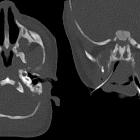membranöse Choanalatresie



membranöse Choanalatresie
Choanalatresie Radiopaedia • CC-by-nc-sa 3.0 • de
Choanal atresia refers to a lack of formation of the choanal openings. It can be unilateral or bilateral.
Epidemiology
It frequently presents in neonates where it is one of the commonest causes of nasal obstruction in this age group. There is a recognized female predilection. The incidence is estimated at ~1:5000-8000.
Clinical presentation
Presentation depends on whether it is uni- or bilateral. Unilateral choanal atresia presents late and can be asymptomatic or present with rhinorrhea. Bilateral atresia can present with neonatal respiratory distress as infants are obligate nose breathers. Another finding is failure to pass a nasogastric tube.
Approximately two-thirds of cases are unilateral .
Pathology
Structurally there are two main types:
- osseous: ~90%
- membranous: ~10%
Associations
Syndromic associations include
- CHARGE syndrome
- Crouzon syndrome
- DiGeorge syndrome
- amniotic band syndrome
- fetal alcohol syndrome
- Treacher Collins syndrome
Other associations include
General pathogenesis includes
- teratogenic effects caused by early pregnancy use of antithyroid drugs
Radiographic features
CT
Assessment with axial CT may show:
- a uni- or bilateral posterior nasal narrowing with an obstruction
- airway less than 3 mm
- measurement done at the reference level of the pterygoid plates in the axial plane
- an air-fluid level above the obstruction point
- thickening of the vomer
- medial bowing of posterior maxillary sinus
Treatment and prognosis
Options include:
- endoscopic perforation (for membranous types)
- full choanal reconstruction
Differential diagnosis
On an axial CT scan consider:
- nasolacrimal duct mucocele
- pyriform aperture stenosis
- sinonasal mucoid impaction
Siehe auch:
und weiter:

 Assoziationen und Differentialdiagnosen zu membranöse Choanalatresie:
Assoziationen und Differentialdiagnosen zu membranöse Choanalatresie:
